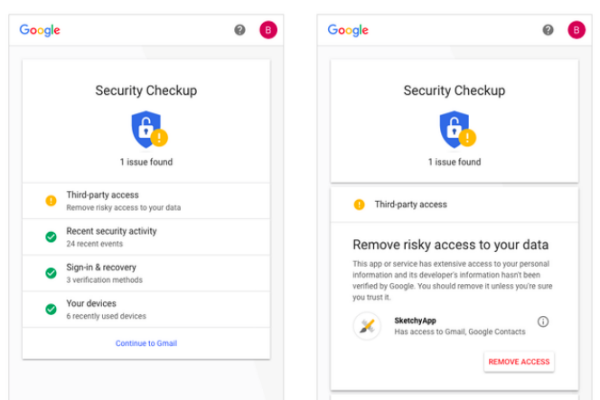 APPS
APPS
 APPS
APPS
 APPS
APPS
Google LLC has revamped its Security Checkup feature to make it personalized for each user, and also added new phishing protections in Chrome.
The Security Checkup is a service that ensures a user’s Google account is safe by checking items that could impact its security, such as connected apps, connected devices and account permissions.
The updated Security Checkup will still provide users with the same information and security risks, but it becomes more personalized. Previously, the Security Checkup provided everyone with the same “passive checklist” regardless if the security risks affected them or not. Now the Security Checkup will provide a tailored version of personalized suggestions for each user.
Earlier this year, Google rolled out Play Protect to better protect Android devices. Play Protect’s features include the ability to detect malicious apps in the Play Store, Safe Browsing protection in Chrome and the “Find My Device” tool. Google subsequently announced in August that all certified Android devices will include Play Protect branding on the devices’ packaging, which in addition to the Play Protect features also includes verification that the Google apps preinstalled on the device are authentic.
Here’s a look at Google’s updated Security Checkup and the new phishing protections in Chrome:
The new Security Checkup page features four sections: Third-party access, Recent security activity, Sign-in & recover and Your Device. But as the service is now personalized per individual user, you will only see the sections relevant to your account.
When you go to the Security Check page, you will automatically see your security status. At the top of the page, you will get a quick glance of the overall health of your account. The Security Checkup shield will either be accompanied by a green checkmark to indicate everything is good. If there are certain security suggestions that you should act on, then you will see either a yellow or red exclamation mark next to the shield, depending on the severity of the risk.
If you have a yellow or red exclamation mark next to the shield, go through the relevant issues and approve any of the suggestions that you are happy with.

Google has offered its Safe Browsing protection for over a decade and currently automatically protects more than 3 billion devices. The Safe Browsing feature will scan the relevant site and alert users if a site is suspected of possible malware or suspicious behavior.
To help protect users from phishing sites that are quickly set up following a scan, Google Chrome is adding predictive phishing protection. If you enter your Google Account password into a suspected phishing site, a pop-up warning notification will alert you that your password could be at risk.
The warning will encourage users to change their password, while the warning prompt will show up persistently across different browsers.
Google plans to expand predictive phishing protection to all other passwords saved in Chrome’s password manager, as well as other apps and browsers that take advantage of the Safe Browsing feature, such as Safari, Firefox and Snapchat.
Support our mission to keep content open and free by engaging with theCUBE community. Join theCUBE’s Alumni Trust Network, where technology leaders connect, share intelligence and create opportunities.
Founded by tech visionaries John Furrier and Dave Vellante, SiliconANGLE Media has built a dynamic ecosystem of industry-leading digital media brands that reach 15+ million elite tech professionals. Our new proprietary theCUBE AI Video Cloud is breaking ground in audience interaction, leveraging theCUBEai.com neural network to help technology companies make data-driven decisions and stay at the forefront of industry conversations.